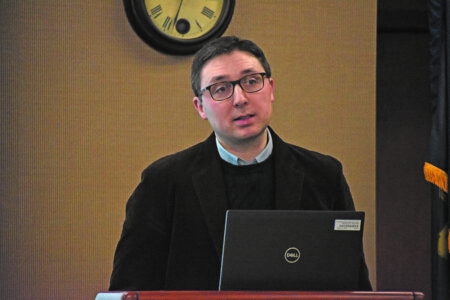UPHS, UGL talk relationship

Garrett Neese/Daily Mining Gazette UP Health System — Portage Chief Executive Officer Randy Neiswonger and Upper Great Lakes Family Health Center Chief Operating Officer Shannon Richter describe their operations at Wednesday’s Keweenaw Alliance Breakfast.
HANCOCK — Determining where UP Health System — Portage ends and the Upper Great Lakes Family Health Center ends has tied up many people in the community.
At Wednesday’s Keweenaw Alliance Breakfast, Portage Chief Executive Officer Randy Neiswonger and UGL Chief Operating Officer Shannon Richter tried to unravel it.
UGL was founded in 2009 as a way to provide quality health care for Keweenaw residents regardless of their ability to pay. It is one of about 1,300 federally qualified health care centers, a designation reserved for private non-profit or public health care organizations that serve underinsured or underserved populations.
Each year, it has about 25,000 unique patients and provides 90,000 clinical visits.
UGL received federal recognition for being in the top 20% of health centers in the U.S. for primary care outcomes.
It has nine sites in the western U.P., including other partnerships with Aspirus.
“We as a community health center partner with our local hospitals, because we can’t do it alone, and they can’t do it alone,” Richter said.
UP Health System — Portage’s roots date back to 1896, when the Saint Joseph’s Hospital opened. It entered into a joint venture with LifePoint in 2013, becoming a for-profit hospital.
Neiswonger stressed the hospital’s High Five guiding principles, which include delivering high-quality care, supporting physicians and taking a leadership role in our communities. For quality metrics, he touted the hospital’s A score in Leapfrog and evaluations from Duke LifePoint.
Changes with for-profit include paying taxes and being able to take donations and apply for grants. When LifePoint took over, it adopted the charity care system that was in place when the hospital was non-profit.
Despite being for-profit, the metrics on which Portage is judged still encourage quality care, Neiswonger said. In pay-for-performance initiatives, Centers for Medicare and Medicaid Services based reimbursement on how well hospitals provide quality initiatives.
“For profit, not for profit, it doesn’t matter,” he said. “We have to make sure that we run efficient, financially viable institutions that can ensure that they can reinvest into their infrastructure to provide the best quality of care for the patient population that we all service.”
Portage also began its partnership with UGL in 2013. One of the biggest distinctions between the two is comprehensive primary care, which falls under UGL.
Their CEOs at the time had agreed to collaborate on grant funding for a quality health center. To their surprise, they received it. At that time, primary care was not a large focus for LifePoint.
“That was something that Don and Jim decided, ‘Hey, let’s keep these providers here, and not have them worry about any cuts,'” Richter said.
To ease the transition, UGL leased many of their providers and staff from Portage. At the Houghton clinic on the Michigan Technological University clinic, that amounted to four providers and 25 employees, Richter said.
Other areas include family medicine, pediatrics, dental care and medication-assisted treatment for opioids.
Portage’s specialties include general surgery, orthopedics, oncology, anesthesiology and express care.
During a question-and-answer session, Guy St. Germain, former executive officer of the Western Upper Peninsula Health Department, asked Neiswonger about any strategy for addressing the duplication of services with Aspirus Keweenaw Hospital.
Having two such hospitals so close to each other in a rural area is rare, Neiswonger said. But he said the competition has resulted in a higher level of care for the area.
Neiswonger said he doesn’t see either hospital going away. He and Aspirus Upper Peninsula Regional President Christina Hauff Tuesday have a similar view of the health care landscape, he said. The two talked Tuesday about how to improve health care locally.
“How do we gain efficiencies?” Neiswonger said. “How do we differentiate ourselves in a meaningful manner that doesn’t necessarily create duplication of services? Is there a way to solve that riddle? It’s too early to tell.”




